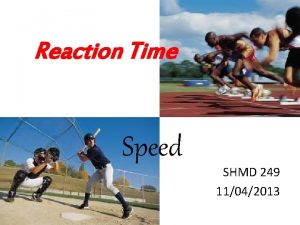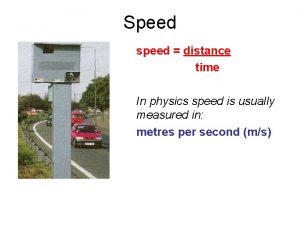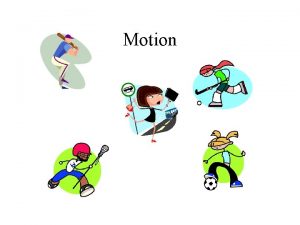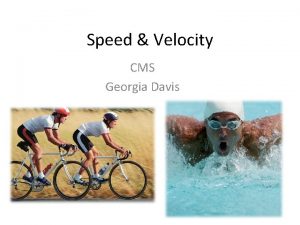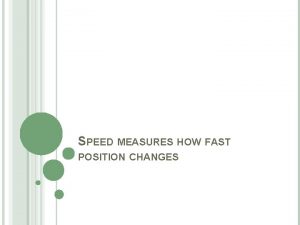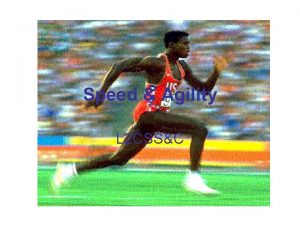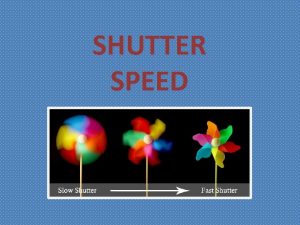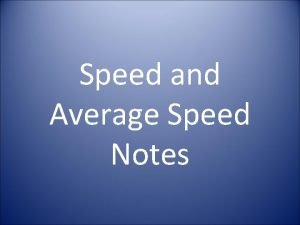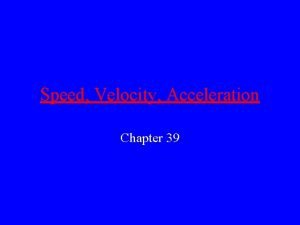REACTION TIME Reaction time is the speed at












- Slides: 12

REACTION TIME • • Reaction time is the speed at which we are able to process information and make decisions Being able to respond quickly is important to success in many sporting situations - A stimulus activates a particular sensory system The stimulus travels from the sensory system to the brain The brain (central mechanism) processes the stimulus and decides on a course of action The appropriate command is sent from the brain to the relevant muscles (effectors) to carry out the action • The process can be explained simply in the following model: input Decision making output

Although we often talk about someone having fast reactions when movements are performed quickly there are three possible components: • REACTION TIME • MOVEMENT TIME • RESPONSE TIME

REACTION TIME • THE TIME BETWEEN THE ONSET OF THE STIMULUS AND THE START OF THE MOVEMENT IN RESPONSE TO IT • Eg. The time between when a sprinter hears the starting gun and starts to move

MOVEMENT TIME • THE TIME TAKEN FROM STARTING THE MOVEMENT TO COMPLETING IT Eg. The time from when a sprinter first presses on their blocks to when they cross the finish line

RESPONSE TIME • THE TIME FROM THE ONSET OF A STIMULUS TO THE COMPLETION OF THE MOVEMENT • Eg. The time from the sprinter hearing the stimulus of the gun to finishing the race RESPONSE TIME = REACTION TIME + MOVEMNET TIME

FACTORS THAT AFFECT REACTION TIME • • AGE: reaction time gets quicker until approx. age 20, then reactions get slower as you get older GENDER: males generally have faster reaction times LIMB USED: the further information has to travel in the nervous system the slower the reactions. ie. The reaction of feet is slower than hands ALERTNESS/ AROUSAL/ MOTIVATION: levels of these affect reaction time. Optimum levels are needed to react quickly BODY TEMPERATURE: when cold reactions are slower. Performing a ‘warm up’ prepares athletes to react quickly SENSORY SYSTEM RECEIVING THE STIMULUS: reaction time varies depending on the sense being used A WARNING: reactions are quicker when expecting a stimulus eg. In the sprint start knows that after hearing the word ‘set’ the gun will go off • STIMULUS INTENSITY: loud sounds or bright colours stimulate quicker • reactions eg. Use of a starting pistol or a brightly coloured ball in beach volleyball LIKELIHOOD: if there is a good chance of the stimulus occurring reactions will be quicker than to a stimulus that rarely occurs

SIMPLE REACTION TIME • If an athlete only has to respond to one stimulus this is termed ‘ simple reaction time’ Eg. At the start of a race a swimmer only listens for the sound of the starting gun. The only decision to be made is when to start to move

CHOICE REACTION TIME • In many sporting situations performers are faced with more than one stimulus and more than one possible response, This is ‘choice reaction time’ Eg. In badminton an athlete is faced with many stimuli – position of opponent, speed, direction, trajectory of the shuttlecock – and may have to choose between several possible shots in response

HICK’S LAW • Choice reaction time increases linearly as the number of stimulus/ choice alternatives increases • This can be used to slow reactions from opponents Eg. In football a defender will respond more slowly if several attackers are approaching the goal area than if there is only the one player wit the ball

IMPROVING REACTION TIME • PRACTICE – enables performers to improve cue recognition. With practice the response can become automatic • MENTAL REHEARSAL –ensures attention to the correct cues and response to the correct stimuli. It activates the neuro-muscular system like physical training and affects arousal levels • • EXPERIENCE – enhances the performer’s awareness of the probability of particular stimuli occurring STIMULUS-RESPONSE COMPATIBILITY – the more natural or usual the response the quicker the reaction time. Coaches try to create a strong stimulus-response bond (S-R) • CUE DETECTION – analysing an opponent’s play enables an athlete to anticipate what they are going to do and react more quickly to the move • PHYSICAL FITNESS – the fitter you are the quicker you will be • AROUSAL/ MOTIVATION – optimum levels are needed to react quickly • WARM UP –ensures physical and mental preparation • ANTICIPATION – SPATIAL AND TEMPORAL SPATIAL ANTICIPATION – predicting what will happen TEMPORAL –predicting when it will happen • CONCENTRATION/ SELECTIVE ATTENTION – focussing on only relevant information improves reaction time -

PSYCHOLOGICAL REFRACTORY PERIOD • Anticipation can speed up reactions but if we anticipate incorrectly reaction times can be slowed down. • If we detect a stimulus and are processing that information when a second stimulus occurs we are unable to process the second stimulus until we have finished processing the first one, making our reaction times longer • This extra reaction time is known as the ‘psychological refractory period’ (PRP) Eg. By using a dummy in football or a feint dodge in netball we can make defenders move in one direction while we go the other Psychologists explain this by the ‘single-channel hypothesis’ – we have a single channel for processing information and can only process one piece of information at a time

PSYCHOLOGICAL REFRACTORY PERIOD STIMULUS ONE REACTION ONE STIMULUS TWO REACTION TWO PRP
 Speed time distance formula
Speed time distance formula Emotions influence driving because they
Emotions influence driving because they Speed detection of moving vehicle using speed cameras
Speed detection of moving vehicle using speed cameras Comparing distance/time graphs to speed/time graphs
Comparing distance/time graphs to speed/time graphs Hình ảnh bộ gõ cơ thể búng tay
Hình ảnh bộ gõ cơ thể búng tay Frameset trong html5
Frameset trong html5 Bổ thể
Bổ thể Tỉ lệ cơ thể trẻ em
Tỉ lệ cơ thể trẻ em Voi kéo gỗ như thế nào
Voi kéo gỗ như thế nào Chụp phim tư thế worms-breton
Chụp phim tư thế worms-breton Chúa yêu trần thế
Chúa yêu trần thế Các môn thể thao bắt đầu bằng từ đua
Các môn thể thao bắt đầu bằng từ đua Thế nào là hệ số cao nhất
Thế nào là hệ số cao nhất














